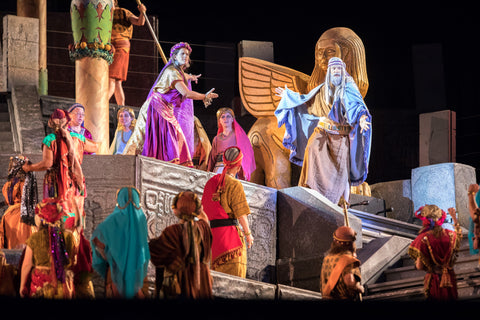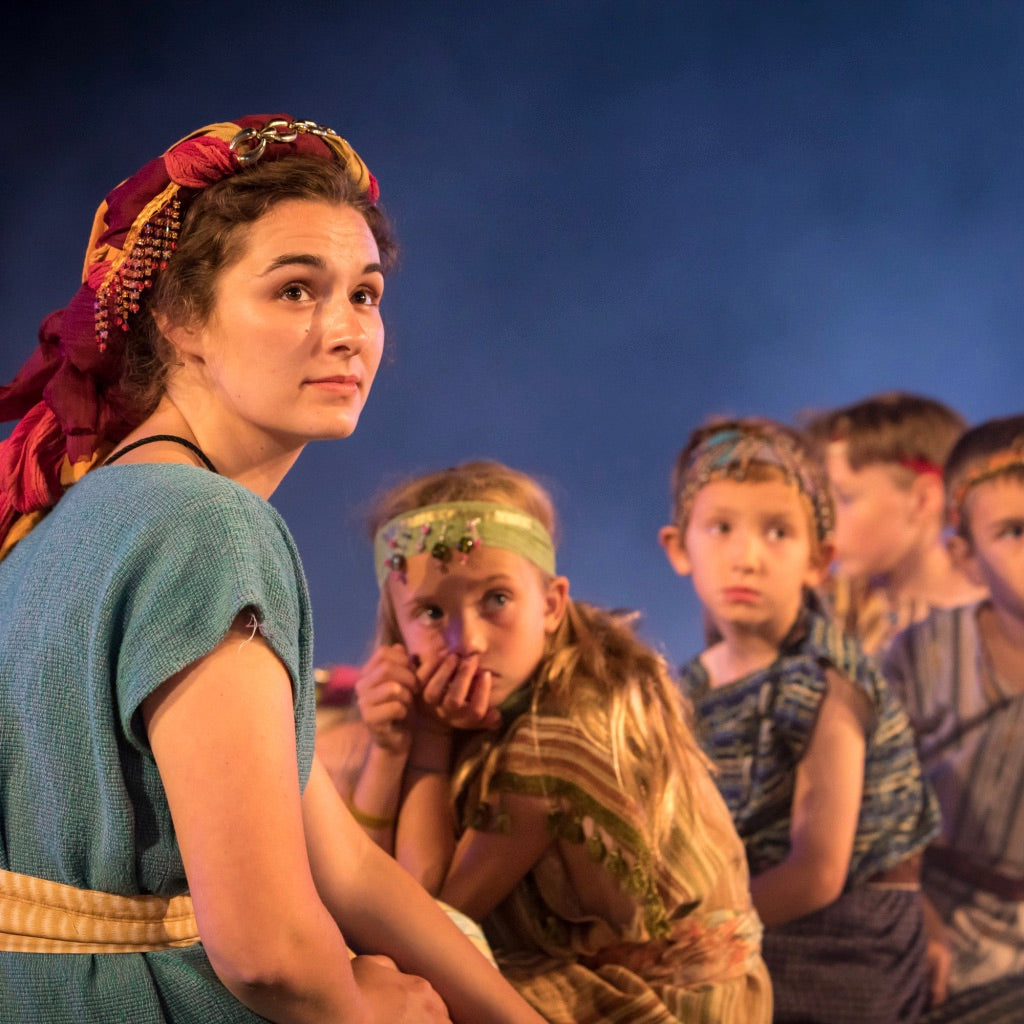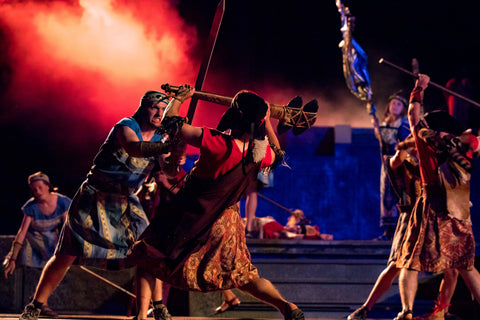When hearing the words Mormon and theater, for many, the first thought is likely the Broadway smash hit “The Book of Mormon.” But every summer, more than 35,000 people journey to the Finger Lakes region, to the historical base of the Mormon faith for a very different theatrical experience — the
Hill Cumorah Pageant. A search to better understand the New York roots of the Church of Jesus Christ of Latter-day Saints (LDS) took New York States of Mind to
Palmyra, a small New York town along the Erie Canal. This is where Joseph Smith, founder of the Church, was living when he claimed to have the vision that became the cornerstone of Mormon beliefs. According to the Church, one day Mr. Smith received instructions not to join any of the established churches in the Palmyra area. Shortly after he was visited by a second message, in this instance directing him to a set of golden plates that recorded the history of the People, buried under what we now know as Hill Cumorah. After working tirelessly to translate the plates, Mr. Smith published “The Book of Mormon: Another Testament of Jesus Christ” on a local printing press. By 1830, Smith and his followers believed he had been called as a prophet, and
he established the Church and became its first president. From the beginning, many Palmyra residents perceived their Mormon neighbors as economically, politically and religiously threatening. Facing persecution, Smith led groups of followers westward to what he hoped would be a friendlier environment. Many members eventually made permanent homes in other states. Though Utah now may be the state associated most closely with the Church, New York remains an important site in shaping Mormon history, and that influence is commemorated every July. Multitudes of international Church members congregate in Palmyra to take part in a theatrical extravaganza that shakes, rattles and rolls the Finger Lakes for seven nights. Dwight Schwendiman, a local Mormon who has served as president of the Hill Cumorah Pageant for eight years, clarifies terminology. “The term ‘Mormon’ refers to those who practice the Mormon religion and are members of LDS,” he explains. “Mormon is a nickname of sorts because we use ‘The Book of Mormon’ in addition to the King James Version of the Bible.” The Pageant showcases a series of stories taken from Smith’s “The Book of Mormon,” Mr. Schwendiman said. As the event’s producer, Mr. Schwendiman helps to select the cast of 700-750 Mormon men, women and youth, and arranges housing, meals, transportation and activities for the group. He laughingly refers to himself as the Steven Spielberg of Hill Cumorah. The Pageant began as a set of skits performed by Mormon missionaries at their annual conference at Joseph Smith’s farm. The first scripted performances began in 1937, detailing Mormon history in the time period of 600 B.C. to 400 A.D. Today, Mormon families and individuals travel from all over the United States, as well as from countries like Germany, South Africa and New Zealand, to take part in the Pageant. For some, it is a “vacation with a meaning.” Mr. Schwendiman adds that participation — 17 days in total — is no small time commitment, and people take their responsibility seriously. Brent Hanson, the Pageant’s director for the past decade, efficiently unites his cast of hundreds from the moment they arrive (on the Friday before the first performance) until the final show. On the first day, aspiring actors and actresses break into groups to audition. Then, simultaneous rehearsals are held daily on the various stages and, by the following Thursday, the show is ready for a final dress rehearsal. This rehearsal draws a crowd of about 2,000 — mostly locals who want to avoid the mobs of the regular performances. Actors and actresses are clad in custom-made costumes ranging from elaborate king’s robes and authentic-looking soldiers’ uniforms, to simpler outfits worn during the harvest season. Little makeup is used, but the cast does rely on plenty of wigs and facial hair pieces.

The Pageant requires seven stages that are erected on the side of the hill and connected around a central pyramid. Mr. Schwendiman tells us that building the structure is quite an endeavor, particularly the 12 light towers which require assembly by more than 20 teenagers over a period of four days. Half of the young men involved in the production then serve as the light crew for the evening performances, and the rest are put in charge of the other special effects including pyrotechnics, waterfalls and water cannons. “‘The Book of Mormon’ talks about ‘great disturbance and upheavals’ so we include about 40 seconds of these. It can be intense,” Mr. Schwendiman explains. In one scene, a large boat constructed on the stages sails into a thunderstorm, calling for another amazing display of lights, water and sound as the sail rips and collapses. Another memorable moment occurs during the opening processional when the entire costumed cast walks through the audience, similar to the beginning of many great medieval pageants.
Mr. Schwendiman observes, “There are primarily three groups who come to Hill Cumorah: local Mormons and Mormons from around the country who treat their visit as a pilgrimage; people from the local community, usually [non-Mormon] Christians who enjoy the Pageant because it reinforces their beliefs; and those who have heard it’s a neat show and that it’s free.” Some audience members come only once, and others return year after year with family and friends. Is there still prejudice towards the Mormons in the Finger Lakes? “Not at all!” Mr. Schwendiman replies emphatically. He adds that in the 1900s, Willard Bean and his family of practicing Mormons settled in Palmyra, and became responsible stalwarts of the community. “Their interactions with the other residents helped to rid the area of any residual animosity,” he notes. The Mormons are committed to serving Palmyra and other small towns in the vicinity (including Manchester, Lyons, Canandaigua and Macedon) when they aren’t rehearsing for the Pageant, Mr. Schwendiman said. Crews of young Mormons, age 15-30, and their leaders volunteer at organizations like Historic Palmyra, 4-H Camp Bristol Hills, schools and local parks. Mr. Schwendiman recommends spending the daylight hours at Palmyra’s four historic sites. Begin at The Hill Cumorah Visitors Center, where Sisters and Elders are available to answer questions or explain the history, concepts and beliefs behind the Mormon religion. A short drive away is the Sacred Grove, the Welcome Center at the
Joseph Smith Farm and the Smith Family Homes, and the
Book of Mormon Historic Publication Site. Mr. Schwendiman emphasizes that Hill Cumorah is both historically interesting and easy to access. “It’s a place to learn more about the Mormon religion in a non-threatening environment.”
IF YOU GO
Hill Cumorah Pageant 603 State Route 21 Palmyra, New York (315) 597-5851
Performances: July 11, 12 and 15-19 at 9:15 p.m. (Duration: One hour and fifteen minutes)
Cost: Free admission and parking, general admission, seating on chairs or the lawn.
Refreshments: Bring a picnic or purchase food at the Lions and Rotary Club concessions. Please note that this is an alcohol and tobacco-free event.
Other: Handicap-accessible; Headsets for Spanish translation are available; American Sign Language Interpretation is provided.




Leave a comment